Question-------------------------
Followup To
Question - Two topics in my follow-up: 1) ammonia testing and 2) water changes
Chris -
Thanks for the Baking Soda tip! pH is now at 7.2 and holding (although it has only been a day, so we'll keep an eye on it!) Two quick follow-up topics ...
1) it's very hard to determine whether an ammonia test uses nessler reagents or not ... any tips to help me out on that one? (Funny thing happenned when we increased our pH, over night, the ammonia level is now reading zero.)
2) what is the affect of water changes on the bacteria in the tank? When I do water changes, am I throwing them out and won't the new water need to cycle? What is the average percentage of my tank I should change out each week?
I need your help again! I have several questions, two which I alluded to in the subject line, but all stem from a recently experienced ammonia spike ... it went to nearly 2ppm. A quick recap of our tank/situation: 90 gal tank installed last April, has been a fish mortuary whenever we add fish due to ich treatments and related follow-up illnesses. We have discontinued all medication (last one was Maracyn, which turned the water cloudy). At two points in time, we have had nearly 60-70 community fish in the tank, and due to recent (failed) attempts to stabilize the envirnment are down to less than 10 (gouramis, white clouds, tetras, and parrot cichlids). We are feeding every other day, and have reduced the amount rather dramatically. At your advice, we have discontinued using RO water and are doing occasional water changes with tap water, treating with AmQuel. We have a Rena canister filter, a Magnum filter (in which we occasionally add diatom - frequency reduced at your advice), and an under-gravel filter with two power heads. To deal with the ammonia, we have been doing daily water changes of roughly 5 gallons, and are using a Python to vacuum the gravel during the water extraction. On to the questions:
1) Where is all this ammonia coming from? With the filtration I'm doing and the reduced feeding, I would think that ammonia would be a non-issue. Are there other sources I'm not thinking of?
2) Do water changes cause harm to the beneficial bacteria in my filter? How much water change can I do without having to worry about damaging the bactierial colonies? I'm assuming they're healthy and alive, given that my Nitrate/Nitrite levels are non-existant - if I change too much water, will I induce a new cycle that will destabilize the tank?
3) Our pH continues to be unusually low - it always tests out at the lowest level in our tests, I'm assuming it is less than 5. We have been attempting to raise it by using PhUp and other similar products, but have not had much luck. As soon as we are able to nudge it up a bit, it goes right back down. A few web-based advice sites suggest reducing pH to assist in lowering ammonia ... I don't think that's a problem for us. A friend recommended Kent pH Precise Neutral Controller, that brings up the pH in their tank ... before I buy it, I thought I'd ask your opinion. We are already using RO Right, another Kent product, to increase the carbonate hardness of the water, which is extremely low as well (17 ppm). Our general hardness is about 170 ppm, which I understand is moderate.
4) Without realizing we were in the midst of an ammonia spike, we introduced 4 parrot cichlids (South American) to the tank. Within minutes after acclimation, all four appeared to vomit up surprisingly large amounts of white material ... food, I would assume. Is that an initial reaction to the ammonia, or something that is normal in fish that are stressed due to a new tank? (I feel like a bad fish owner, introducing them into this toxic environment, we really should have checked the water first - I'll understand if you tell me to give up the hobby, I'm feeling like an instrument of fish death lately).
Sorry if I'm a bit long-winded ... I look forward to your response.
Sincerely -
Ken.
Answer -
Hi Ken;
Don't be so hard on yourself! Nature isn't always kind to us as we try to care for it's creatures.
While the pH is low the ammonia is much less toxic to the fish. The new ones are probably reacting to the low pH and have been shocked by it. They are most likely used to a pH of 7.0 or higher from the fish store and the drastic change may have been too much for them to take.
Make sure that your ammonia test kit doesn't have 'nessler reagents'. If it does, you may be getting a false positive if you have used ammonia removers to condition your water. Ammonia removers like AmQuell and AmmoLock react weird with test kits that have nesslers. They make you think ammonia is there when it may not be at all.
The low pH can actually cause ammonia to hang around because low pH kills the beneficial bacteria. Usually at 5.8 or lower it just can't survive as well. Chronic ammonia levels are the result until the pH is kept higher where the bacteria can thrive.
The easiest and most natural way to help the pH rise is by adding more oxygen to the water. Add a good sized air pump hooked to a long airstone. (It looks nice too.) If that doesn't help at all in 24 hours, add common baking soda to the tank. It raises the KH. I usually start with a dosage of one teaspoon for every ten gallons of tank water. Dissolve it in a cup of water and pour it in slowly. Test the pH in 12 hours. Add more if it still hasn't risen and stayed there. SO much cheaper than buying a jar full of stuff at the fish store. Adding rinsed crushed coral or crushed oyster shell to the tank will help too. Go to the salt water department of a good fish store to find something like that. Salt water tanks need a higher pH so the gravel will be a type like this. You can either add it to the gravel you have or replace yours with the high mineral new stuff. Limestone rock pieces work too. Just monitor the pH daily for a few weeks to be sure you acheive the desired result.
Have a Merry Christmas and Happy New Year!!!!!
Followups welcome
At Your Service;
Chris Robbins
Come on over and join us on the freshwater fish forum at About.com to get even more information too;
http://freshaquarium.about.com/od/questionsanswers/a/naavigateforum.htm
My member name is ChrisR62. See You There!
AnswerHi Ken;
I'm glad to hear everything is straightening out!
The way to tell if you have nessler reagents is what color the tested water turns. Nesslers make the positive result turn from clear to yellowish or orangish and need only one tablet or one bottle of drops, like this link shows; http://www.goldfishinfo.com/ammonia.htm
Non-nesslers are usually green and need at least 2 different tablets or usually 3 different drops to complete the test.
The beneficial bacteria in the tank lives in the gravel, on the filter pads, and on other surfaces. Since it doesn't swim around in the water you don't have to worry about how water changes affect it's populations. The partial water changes done during break-in or imbalances keeps the fish comfy without shocking them. The bacteria still has some of the toxins to feed on this way too so it can continue to develop. Replacing all the water would shock the fish and starve the bacteria colonies so it is best to avoid that when toxins are high. The system or bacteria colony 'cycles' and not actually the water. Replace 25% at a time. Do it every week in a tank that is going normally. Up to daily in a tank that is having trouble or in break-in.
Followups welcome
At Your Service;
Chris Robbins

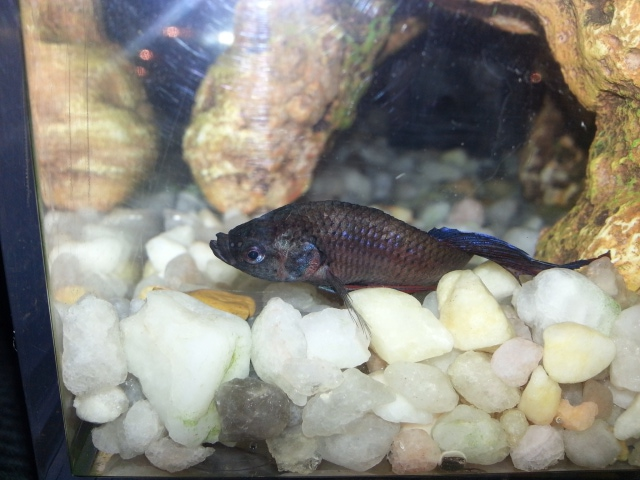 Sick Betta
Question
Image 1 Image 2
My Betta has been
Sick Betta
Question
Image 1 Image 2
My Betta has been
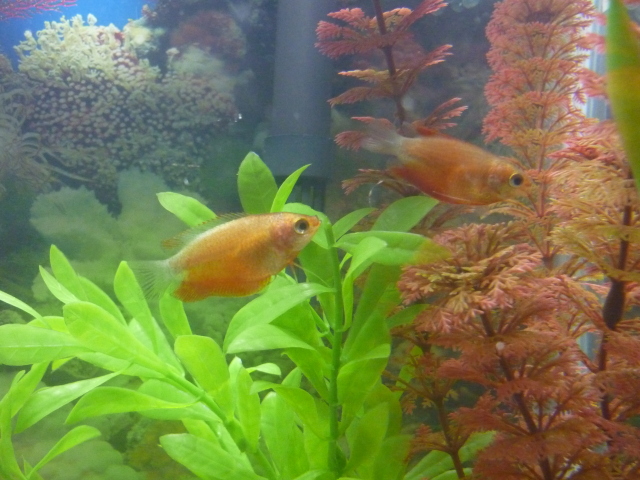 Red Dwarf Gouramis.
Question
Red Gouramis
I recently bought to red dwarf go
Red Dwarf Gouramis.
Question
Red Gouramis
I recently bought to red dwarf go
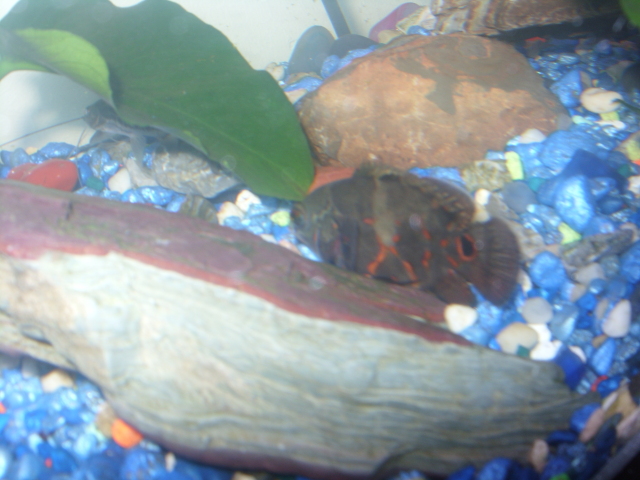 My sick oscar fish
Question
Sick Oscar
I recently purchased an oscar whic
My sick oscar fish
Question
Sick Oscar
I recently purchased an oscar whic
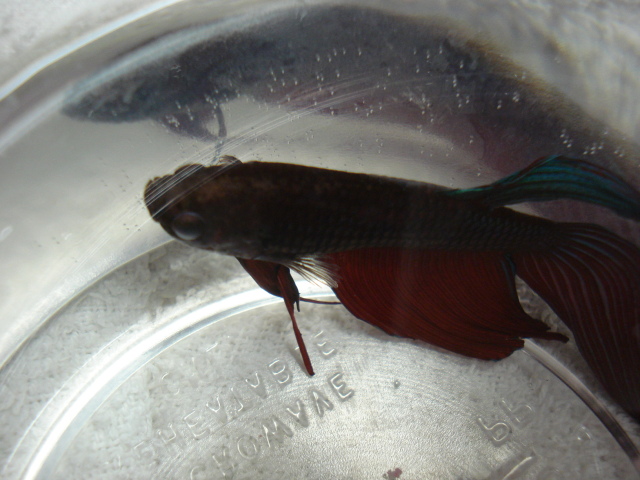 betta with beginnings of fungus..
Question
Mercutio- fungus?
Hi! My betta Mercutio has wh
betta with beginnings of fungus..
Question
Mercutio- fungus?
Hi! My betta Mercutio has wh
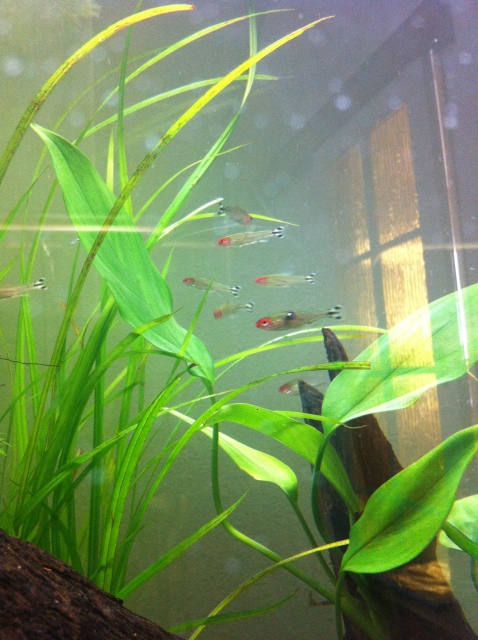 black mark on a rummy nose tetra
Questionsick rummynose
QUESTION: Hi there,
I ho
black mark on a rummy nose tetra
Questionsick rummynose
QUESTION: Hi there,
I ho